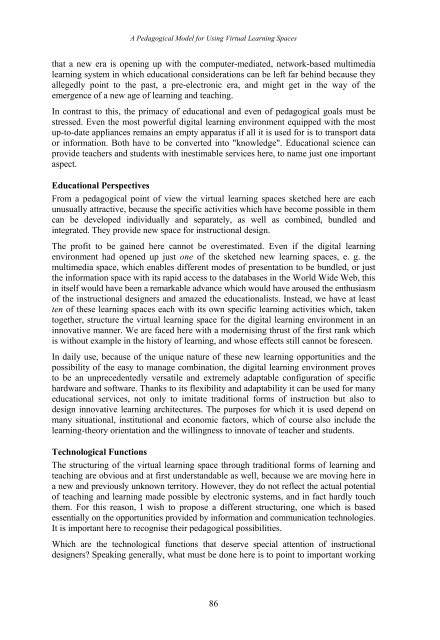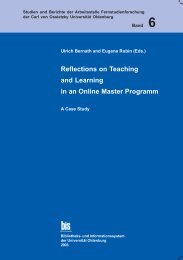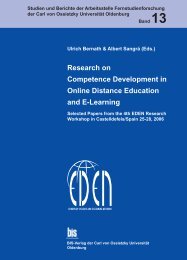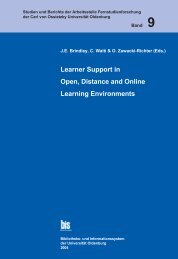Distance Education in Transition - Master of Distance Education ...
Distance Education in Transition - Master of Distance Education ...
Distance Education in Transition - Master of Distance Education ...
Create successful ePaper yourself
Turn your PDF publications into a flip-book with our unique Google optimized e-Paper software.
A Pedagogical Model for Us<strong>in</strong>g Virtual Learn<strong>in</strong>g Spaces<br />
that a new era is open<strong>in</strong>g up with the computer-mediated, network-based multimedia<br />
learn<strong>in</strong>g system <strong>in</strong> which educational considerations can be left far beh<strong>in</strong>d because they<br />
allegedly po<strong>in</strong>t to the past, a pre-electronic era, and might get <strong>in</strong> the way <strong>of</strong> the<br />
emergence <strong>of</strong> a new age <strong>of</strong> learn<strong>in</strong>g and teach<strong>in</strong>g.<br />
In contrast to this, the primacy <strong>of</strong> educational and even <strong>of</strong> pedagogical goals must be<br />
stressed. Even the most powerful digital learn<strong>in</strong>g environment equipped with the most<br />
up-to-date appliances rema<strong>in</strong>s an empty apparatus if all it is used for is to transport data<br />
or <strong>in</strong>formation. Both have to be converted <strong>in</strong>to "knowledge". <strong>Education</strong>al science can<br />
provide teachers and students with <strong>in</strong>estimable services here, to name just one important<br />
aspect.<br />
<strong>Education</strong>al Perspectives<br />
From a pedagogical po<strong>in</strong>t <strong>of</strong> view the virtual learn<strong>in</strong>g spaces sketched here are each<br />
unusually attractive, because the specific activities which have become possible <strong>in</strong> them<br />
can be developed <strong>in</strong>dividually and separately, as well as comb<strong>in</strong>ed, bundled and<br />
<strong>in</strong>tegrated. They provide new space for <strong>in</strong>structional design.<br />
The pr<strong>of</strong>it to be ga<strong>in</strong>ed here cannot be overestimated. Even if the digital learn<strong>in</strong>g<br />
environment had opened up just one <strong>of</strong> the sketched new learn<strong>in</strong>g spaces, e. g. the<br />
multimedia space, which enables different modes <strong>of</strong> presentation to be bundled, or just<br />
the <strong>in</strong>formation space with its rapid access to the databases <strong>in</strong> the World Wide Web, this<br />
<strong>in</strong> itself would have been a remarkable advance which would have aroused the enthusiasm<br />
<strong>of</strong> the <strong>in</strong>structional designers and amazed the educationalists. Instead, we have at least<br />
ten <strong>of</strong> these learn<strong>in</strong>g spaces each with its own specific learn<strong>in</strong>g activities which, taken<br />
together, structure the virtual learn<strong>in</strong>g space for the digital learn<strong>in</strong>g environment <strong>in</strong> an<br />
<strong>in</strong>novative manner. We are faced here with a modernis<strong>in</strong>g thrust <strong>of</strong> the first rank which<br />
is without example <strong>in</strong> the history <strong>of</strong> learn<strong>in</strong>g, and whose effects still cannot be foreseen.<br />
In daily use, because <strong>of</strong> the unique nature <strong>of</strong> these new learn<strong>in</strong>g opportunities and the<br />
possibility <strong>of</strong> the easy to manage comb<strong>in</strong>ation, the digital learn<strong>in</strong>g environment proves<br />
to be an unprecedentedly versatile and extremely adaptable configuration <strong>of</strong> specific<br />
hardware and s<strong>of</strong>tware. Thanks to its flexibility and adaptability it can be used for many<br />
educational services, not only to imitate traditional forms <strong>of</strong> <strong>in</strong>struction but also to<br />
design <strong>in</strong>novative learn<strong>in</strong>g architectures. The purposes for which it is used depend on<br />
many situational, <strong>in</strong>stitutional and economic factors, which <strong>of</strong> course also <strong>in</strong>clude the<br />
learn<strong>in</strong>g-theory orientation and the will<strong>in</strong>gness to <strong>in</strong>novate <strong>of</strong> teacher and students.<br />
Technological Functions<br />
The structur<strong>in</strong>g <strong>of</strong> the virtual learn<strong>in</strong>g space through traditional forms <strong>of</strong> learn<strong>in</strong>g and<br />
teach<strong>in</strong>g are obvious and at first understandable as well, because we are mov<strong>in</strong>g here <strong>in</strong><br />
a new and previously unknown territory. However, they do not reflect the actual potential<br />
<strong>of</strong> teach<strong>in</strong>g and learn<strong>in</strong>g made possible by electronic systems, and <strong>in</strong> fact hardly touch<br />
them. For this reason, I wish to propose a different structur<strong>in</strong>g, one which is based<br />
essentially on the opportunities provided by <strong>in</strong>formation and communication technologies.<br />
It is important here to recognise their pedagogical possibilities.<br />
Which are the technological functions that deserve special attention <strong>of</strong> <strong>in</strong>structional<br />
designers? Speak<strong>in</strong>g generally, what must be done here is to po<strong>in</strong>t to important work<strong>in</strong>g<br />
86





